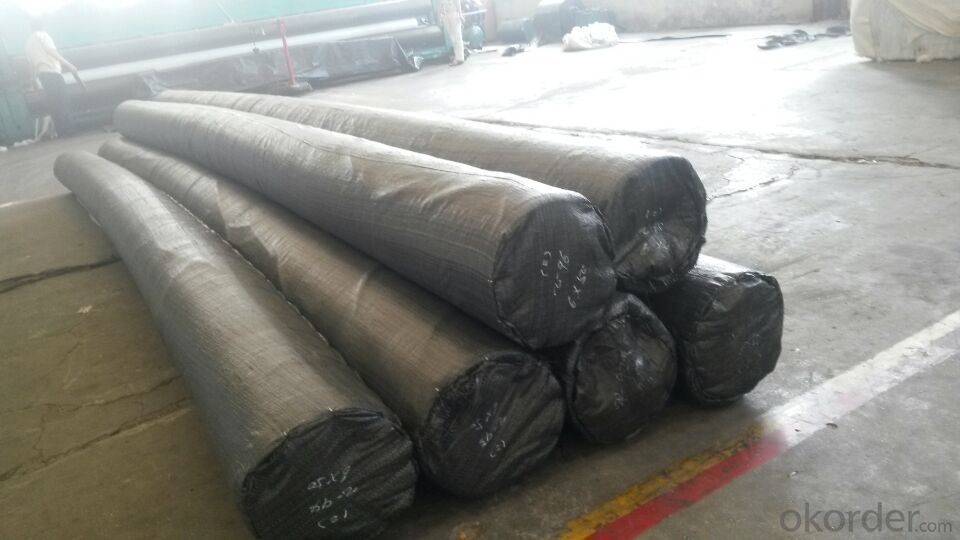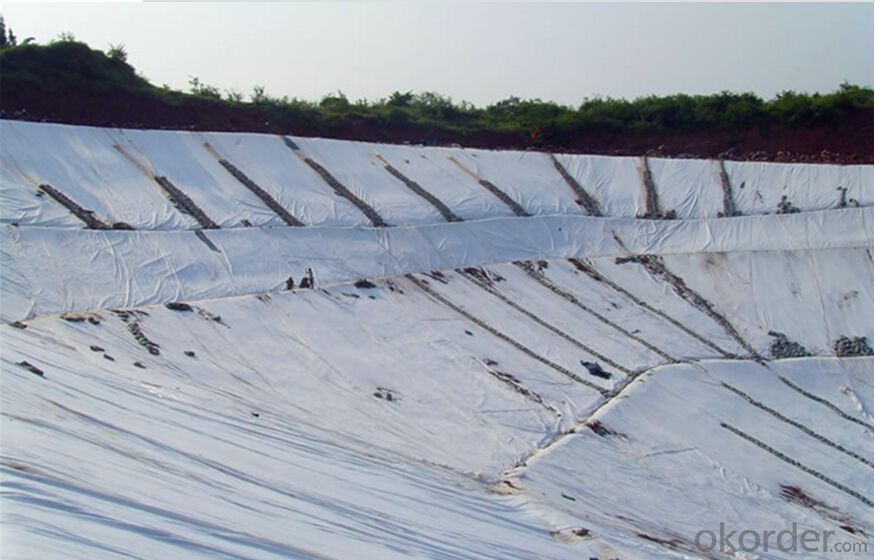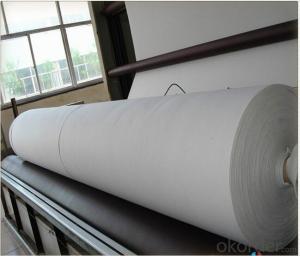Geotextile Non Woven PP Earthwork for Road and Railway
- Loading Port:
- Tianjin
- Payment Terms:
- TT or LC
- Min Order Qty:
- 5000 m²
- Supply Capability:
- 2000000 m²/month
OKorder Service Pledge
OKorder Financial Service
You Might Also Like
Quick Details
Type: GeotextilesPlace of Origin: Hebei, China (Mainland)Brand Name: CMAX GeotextileModel Number: HT3258Geotextile Type: Non-Woven GeotextilesColor: Black , white , greyApplying Area: Road,River bank , lake dam, mine remainings, reservior, tunnelManufacturing method: Nonwoven / wovenWidth: within 8mWeight: 100-1500gsmLength: 50-100m/roll;at requestName: PP Geo Fabric Rolls/ geotxtile used in garbage burying field
Packaging & Delivery
Packaging Details:pallet and design the packing according to client's requestsDelivery Detail:15-30days after received deposit
Landfill Geotextile Polyurea
1. Geotextile Specifications
1) Weight / Mass: 100g/m2-1500g/m2 .
2) Width: Within 8 m (1m-8m as request ).
3) Length: 50m-100m/roll (as request).
4) Material: PP / PET .
5) Certificate: CE/ISO9001/ISO14001
6) Manufacturing method: nonwoven / woven.
2. nonwoven geotextile Features :
1) Staple fibers geotextile:
The geotextile is made of polypropylene staple fibers on cross-laying equipment and needle punched equipment.
It owns the advantages of acid and alkali resistance, erosion resistance, aging resistance, large strength, stable size, good filtrability etc.
2) Filament geotextile:
Filament geotextile has features as follows: High strength, good capacity of elongation and high biology tolerance, alkali tolerance, acidity tolerance, weather resistance good filtration and fine drainage capacity etc. Also it is of low cost, easy in construction and use effects.
3. geotextile Applications
1) Filtration geotextile:
The filtration layer of the dykes, river canal, seacoast, concrete slope, retaining walls. At the same time of preventing the clay granule from passing, it allows the water and the gas pass through freely.
2) Separation geotextile:
The isolation of the railway dregs and the roadbed, roadbed and the soft base, surface of the airdrome and parking lot and the groundsill, different dam materials. It isolates the soil and the gravel of two kinds different granule pathway from the groundsill or other buildings.
3)Adding geotextile:
The highway, railway, soil-stone dam, breakwater, airport, backfill soil of retaining wall, slope protection, etc in which distributes the earth stress, prevents the side-displacement of the earth body and improves the earth body stability.
4) Protection geotextile:
It prevents the bank from being washed out, protects the bank and the bottom, prevents the water and soil from being washed away.

Application
It widely used in civil environmental engineering and construction projects . Such as railway , highway , road , landfill , gymnasium , dike , marine works , tunnel , tide flat , reclamation and environment protection projects.
They use include:
u Filtration of soils in drainage applications by retaining soil particles while allowing for the free flow of water
u Separation and stabilization in road and railway construction
u Prevention of soil movement in erosion control measures
u Cushioning and protection in many containment projects
Service we can provide
1. Good after sales service: Any small problem happening will be solved at the most prompt time;
2.We have many years of experience, we have specializing in fastener;
3. Specifications list is available upon your request
4. Welcome to send enquiry,we will reply soon.If you want to know more,pls feel free to contact us.
5. Prompt shipment with professional documents
6. Packing as your request, with photo before shipment
7. High quality and competitive price




- Q:How do geotextiles contribute to soil improvement in soft ground areas?
- Geotextiles contribute to soil improvement in soft ground areas by providing reinforcement, stabilization, and separation functions. They act as a barrier between the soil layers, preventing mixing and promoting drainage. Geotextiles also distribute loads more evenly, reducing the risk of soil settlement and increasing the overall stability of the ground. Additionally, these materials can help control erosion by effectively retaining soil particles while allowing water to pass through, minimizing surface runoff and maintaining the integrity of the soil.
- Q:What are the different geotextile filter criteria?
- The different geotextile filter criteria include permeability, retention, durability, and compatibility. Permeability refers to the ability of the geotextile to allow water to pass through while retaining soil particles. Retention is the capability of the geotextile to prevent soil particles from passing through, ensuring effective filtration. Durability assesses the geotextile's resistance to physical and chemical degradation over time. Compatibility refers to the geotextile's compatibility with the soil and other materials it is in contact with, ensuring long-term effectiveness.
- Q:300g / m2 geotextile permeability coefficient is generally how much?
- Geotextile cloth short fiber geotextile and long fiber geotextile, the two geotextile permeability coefficient is basically the same. According to the requirements of the national standard 300g / ㎡ geotextile permeability coefficient for the K * (10 negative side ~ 10 negative three power), K is between 1.0-9.9 values. From the indicators can be seen 300g / ㎡ specifications of the geotextile has a good water filter, can be used for water, filter them.
- Q:Do you want to use glue to connect the geotextile?
- Hello, geotextile is not glue to connect, with needle and thread stitching, the request is not too high, but also intestinal smooth spot heap stupid do not need to stitch, as long as take the lead, put up on it.
- Q:Can geotextiles be used in shoreline revetment projects?
- Yes, geotextiles can be used in shoreline revetment projects. Geotextiles are commonly used to stabilize soil and prevent erosion in various civil engineering projects, including shoreline revetments. They can help reinforce the revetment structure, retain soil particles, and provide filtration, thereby enhancing the overall stability and effectiveness of the revetment system.
- Q:What are the advantages of using geotextiles over traditional construction materials?
- Geotextiles offer several advantages over traditional construction materials. Firstly, they provide enhanced stability and reinforcement to the soil or other substrates, reducing the need for extensive excavation or additional structural support. Secondly, geotextiles are permeable, allowing water to pass through while preventing soil erosion, thus improving drainage and reducing the risk of flooding. Additionally, geotextiles are lightweight and easy to handle, making them cost-effective and efficient to install. Lastly, these materials have high resistance to environmental factors such as chemicals, UV radiation, and biological degradation, enhancing their longevity and durability. Overall, geotextiles provide a versatile and sustainable solution for a wide range of construction applications.
- Q:What are the different weight options available for geotextiles?
- Geotextiles come in various weight options ranging from lightweight to heavyweight. The weight options typically available include 3-5 oz/sq.yd for lightweight, 6-8 oz/sq.yd for medium weight, and 10-16 oz/sq.yd for heavyweight geotextiles.
- Q:Why do you want to add 1 to the amount of geotextile
- There are overlapping area and loss, I am specializing in the production of geotextiles
- Q:How do geotextiles help with asphalt pavement reinforcement?
- Geotextiles help with asphalt pavement reinforcement by providing a strong and stable base for the asphalt layer. They prevent the mixing of different soil layers, distribute loads evenly, and increase the tensile strength of the pavement. Additionally, geotextiles help to reduce cracking, rutting, and other forms of pavement distress, resulting in a longer-lasting and more durable road surface.
- Q:How do geotextiles improve the performance of railway tracks?
- Geotextiles improve the performance of railway tracks by providing reinforcement and stabilization to the track bed, preventing soil erosion and reducing settlement. They also enhance drainage, reducing water accumulation and improving the overall resilience and durability of the tracks.
1. Manufacturer Overview |
|
|---|---|
| Location | |
| Year Established | |
| Annual Output Value | |
| Main Markets | |
| Company Certifications | |
2. Manufacturer Certificates |
|
|---|---|
| a) Certification Name | |
| Range | |
| Reference | |
| Validity Period | |
3. Manufacturer Capability |
|
|---|---|
| a)Trade Capacity | |
| Nearest Port | |
| Export Percentage | |
| No.of Employees in Trade Department | |
| Language Spoken: | |
| b)Factory Information | |
| Factory Size: | |
| No. of Production Lines | |
| Contract Manufacturing | |
| Product Price Range | |
Send your message to us
Geotextile Non Woven PP Earthwork for Road and Railway
- Loading Port:
- Tianjin
- Payment Terms:
- TT or LC
- Min Order Qty:
- 5000 m²
- Supply Capability:
- 2000000 m²/month
OKorder Service Pledge
OKorder Financial Service
Similar products
New products
Hot products
Hot Searches
Related keywords































